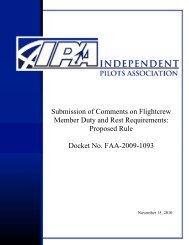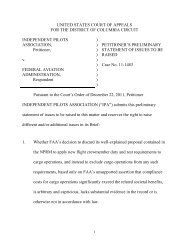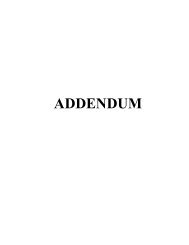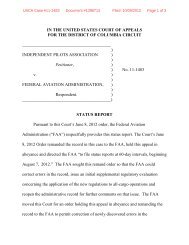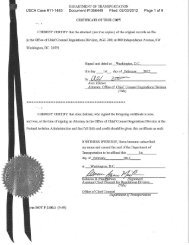Exhibits Vol 2 - Independent Pilots Association
Exhibits Vol 2 - Independent Pilots Association
Exhibits Vol 2 - Independent Pilots Association
Create successful ePaper yourself
Turn your PDF publications into a flip-book with our unique Google optimized e-Paper software.
258 N. Lamond and D. Dawson<br />
Table 2<br />
Summary of linear regression analysis of neurobehavioural performance variables<br />
Performance parameter DF F P R2 % decrease<br />
SW condition<br />
(per hour)<br />
GRG response latency 1,4 70.61 0.0011 0.95 2.69<br />
GRG accuracy 1,4 3.64 NS — —<br />
VIG response latency 1,4 98.54 0.0006 0.96 1.98<br />
VIG accuracy 1,4 81.79 0.0008 0.95 0.61<br />
Unpredictable tracking 1,4 70.93 0.011 0.95 3.36<br />
Simple sensory 1,4 4.71 NS — —<br />
Alcohol condition<br />
(per 0.01% BAC)<br />
GRG response latency† 1,2 74.30 0.0132 0.97 2.37<br />
GRG accuracy 1,4 31.07 0.0051 0.89 0.68<br />
VIG response latency 1,4 12.65 0.0002 0.98 2.05<br />
VIG accuracy∗ 1,3 212.37 0.0007 0.99 0.29<br />
Unpredictable tracking∗ 1,3 238.52 0.0006 0.99 2.68<br />
Simple sensory 1,4 5.37 NS — —<br />
∗ Based on data from 0.02%–0.10% BAC; † Based on data from 0.04%–0.10% BAC.<br />
Alcohol intoxication condition<br />
wakefulness was calculated using a linear regression between<br />
the 17th (equivalent to 23.00 h) and 27th hour of wakefulness.<br />
Table 1 displays the results of the anovas run on each<br />
As indicated in Table 2, regression analyses revealed a<br />
performance variable as a function of BAC. Five of the six<br />
significant linear correlation (P=0.0011–0.0001) between mean<br />
performance parameters significantly (P=0.0008–0.0001)<br />
relative performance and hours of wakefulness for four of the<br />
decreased as BAC increased, with poorest performance<br />
six performance variables. Between the 17th and 27th hours<br />
resulting at a BAC of 0.10% or greater.<br />
of wakefulness the decrease in performance relative to baseline<br />
The linear relationship between increasing BAC and<br />
ranged from 0.61 to 3.35% per hour (Table 2).<br />
performance impairment was analysed by regressing mean<br />
relative performance against BAC for each 0.02% interval. As<br />
is evident in Table 2, there was a significant (P=0.0132–0.0002) Fatigue and alcohol intoxication<br />
linear correlation between BAC and mean relative performance<br />
The primary aim of the present study was to express the effects<br />
for all of the variables except one. It was found that for each<br />
of fatigue on a range of neurobehavioural performance tasks<br />
0.01% increase in BAC, the decrease in performance relative<br />
as a blood alcohol equivalent. Figures 1–6 illustrate the<br />
to baseline ranged from 0.29 to 2.68%.<br />
comparative effects of alcohol intoxication and fatigue on the<br />
six performance parameters. When compared to the<br />
Placebo condition<br />
impairment of performance caused by alcohol at a BAC of<br />
To ensure that differences in performance reflected only the 0.10%, the same degree of impairment was produced after<br />
effects of actual alcohol intoxication a placebo condition was 20.3 (grammatical reasoning response latency), 22.3 (vigilance<br />
incorporated into the study. As indicated in Table 1, mean accuracy), 24.9 (vigilance response latency) or 25.1 (tracking<br />
relative performance in the placebo condition did not accuracy) hours. Even after 28 h of sustained wakefulness,<br />
significantly vary.<br />
neither of the remaining two performance variables<br />
(grammatical reasoning accuracy and simple sensory<br />
Sustained wakefulness condition<br />
comparison) decreased to a level equivalent to the impairment<br />
observed at a BAC of 0.10%.<br />
Table 1 displays the results of the anovas for each performance<br />
variable as a function of hours of wakefulness. Four of the six<br />
performance parameters showed statistically significant (P=<br />
DISCUSSION<br />
0.0001) variation by hours of wakefulness. In general, the In the present study moderate levels of alcohol intoxication<br />
hours-of-wakefulness effect on each performance parameter had a clearly measurable effect on neurobehavioural<br />
was associated with poorest performance resulting after 25–27 h performance. We observed that as blood alcohol concentration<br />
of wakefulness.<br />
increased performance on all the tasks, except for one,<br />
Since there is a strong non-linear component to the significantly decreased. A similar effect was observed in the<br />
performance data, which remained at a fairly stable level sustained wakefulness condition. As hours of wakefulness<br />
throughout the period which coincides with their normal increased performance levels for four of the six parameters<br />
waking day, the performance decrement per hour of significantly decreased. Comparison of the two effects indicated<br />
© 1999 European Sleep Research Society, J. Sleep Res., 8, 255–262



